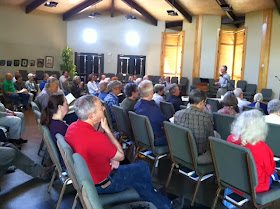Yesterday,
Governor Jan Brewer of Arizona
That Course Was Charted Before
I have witnessed
first-hand the subtle, and not-so-subtle, use of religious values to justify
hatred and prejudice. I am a product of public education, having entered public
school in 1961 at the age of six, and continuing until 1973 when I graduated
from high school. All of my public education occurred in “the heart of Dixie ” as the state of Alabama
I also witnessed
the spin that Christian private schools put on their mission statements. Their
primary claim was that “God had been taken out of the public schools,” citing
the removal of prayer in schools and the teaching of evolution instead of
creationism. Being a somewhat observant high school student, I couldn’t help
noticing the actual progression of events that motivated the establishment of
so many “Christian academies” throughout the South.
 First of all,
there is the matter of teaching evolution in schools. The landmark court case
that established the ability of schools to freely teach accepted science was,
of course, the Scopes Trial in 1925. It became clear from that time on that
schools could not disallow the teaching of scientific theory on the basis of
religious belief. By the time I entered public school, it was well established that
science textbooks in public schools included the theory of evolution. Religious
conservatives did not like this turn of events, but they were not motivated to
create their own school system.
First of all,
there is the matter of teaching evolution in schools. The landmark court case
that established the ability of schools to freely teach accepted science was,
of course, the Scopes Trial in 1925. It became clear from that time on that
schools could not disallow the teaching of scientific theory on the basis of
religious belief. By the time I entered public school, it was well established that
science textbooks in public schools included the theory of evolution. Religious
conservatives did not like this turn of events, but they were not motivated to
create their own school system. Next, fast forward to
1963 when the Supreme Court ruled that public schools could not force students to participate in prescribed public prayer. Religious conservatives were upset by the removal of prayer from schools, they railed against the notion,
but they were not motivated to create their own school system. Even though many religious leaders were shocked by the Supreme Court decision regarding prayer in schools, and many were upset by the increasing "secularization" of society as evidenced by the ascendancy of science and the teaching of evolution in the classroom, there was little movement toward the establishment of church-based schools at the elementary or high school level.
Next, fast forward to
1963 when the Supreme Court ruled that public schools could not force students to participate in prescribed public prayer. Religious conservatives were upset by the removal of prayer from schools, they railed against the notion,
but they were not motivated to create their own school system. Even though many religious leaders were shocked by the Supreme Court decision regarding prayer in schools, and many were upset by the increasing "secularization" of society as evidenced by the ascendancy of science and the teaching of evolution in the classroom, there was little movement toward the establishment of church-based schools at the elementary or high school level.
Within a few
more years, however, racial segregation was no longer allowed in public
schools. It was a tumultuous time in the South, but it was also difficult across the country. My state became infamous for the image of Governor George Wallace standing in the doorway of the University of Alabama to prevent the admission of black students. In my hometown, integration was phased in from 1967 to 1971. Suddenly,
religious conservatives became motivated to create their own private schools.
They would claim a return to God and sacred values to be their raison d'être.
The timing, however, was indisputable. It was, in fact, racial integration in
public schools that spurred the sudden rise in private schools across the
South.
Can We Learn from the Past?
Today, we are
seeing yet again the use of religion to justify bigotry and hatred. It is
distressing to see religion joining hands with hate more readily than siding
with justice. Religion, after all, is only as good as those who practice it.
There is healthy religion which calls us to a higher path of love, compassion and social
justice; and there is unhealthy religion which encourages us to stay where we
are comfortable and cast stones at anyone who is not part of our particular
group.
Thankfully,
Arizona has backed away from legalizing bigotry and has not allowed hatred
cloaked as religion to hold sway. There are yet other states which are considering similar discriminatory bills. Perhaps the time has come for good
people to say no to the voices of hate.
-



.jpg)










.jpg)





.jpg)

